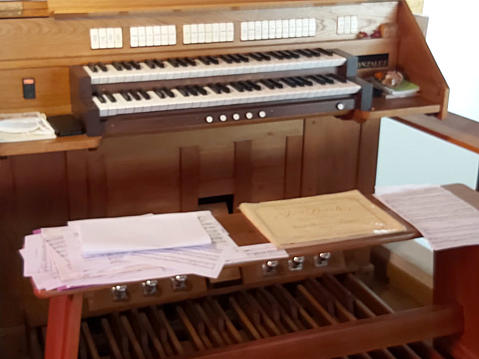


ORGANS OF PARIS © 2024 Vincent Hildebrandt HOME ALL ORGANS


This church is located in the heart of the
Faubourg Saint Antoine. At the beginning of the
20th century, there were many craftsmen,
including carpenters and cabinetmakers. Aware
of the lack of evangelization, Father Anizan
created the Sons of Charity to fill this spiritual
void. In 1928, he had a concrete chapel built,
unfortunately not solid. So, it was destroyed in
1994 and replaced by the current building.
Notre-Dame d'Espérance is a contemporary
church, mixing concrete and glass for the walls,
metal and wood for the interior. Dedicated in
1997, it is the work of architect Bruno Legrand. Its
most original point is the large glass wall in front.
Excerpts from the Gospels of Matthew, Mark and
Luke are engraved in "boustrophédon" mode:
only one line out of two is readable; you have to
go to the other side of the glass to read the rest.
The architect incorporated some works of art
from the old church.
Organiste titulaire
Vincent Guyot
Concerts
-
Masses with organ
Saturday at 6:30 p.m., Sunday 10:30 a.m.
Video
-

D5
According to the archives, this organ is an old cinema
organ built by John Abbey. Transformed and expanded by
Victor Gonzalez for the former little church of Our Lady of
Hope in 1946, the instrument was inaugurated by André
Marchal.
This organ is composed of about twenty real stops,
spread over 2 keyboards and pedals with electric traction
mounted on a separate console. There is no case and its
façade is composed of 15 tin pipes arranged in mitre and
framed by 2 groups of 3 wooden pipes. The base is
plywood.
Before the destruction of the old church, the organ was
dismantled and in 1998 reassembled by Marc Hédelin in
the choir of the new church. He made several important
modifications while respecting the initial stoplist of the
instrument and he rebuilt the console.
Later, the instrument was fully restored by Bernard
Dargassies.
Its piping is embedded in an alcove of the choir, masked
by stretched canvases of the same tone as the walls. Only
2 platforms of tin pipes that make up the bass of the
Montre and frame 3 wooden pipes are the visible part of
the instrument.
The console is deported to a side stand along the nave
allowing, from the keyboards, a plunging view of the choir.
With its duplication and extensions, notably on the pedal
(funds 16', 8' and 4', reeds 16', 8' and 4'), this organ of 24
stops on the console represents a fine example of the
neo-classical organ.
Text and photos: Thierry Correard.
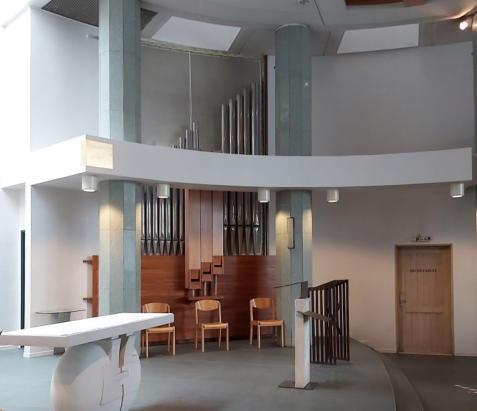
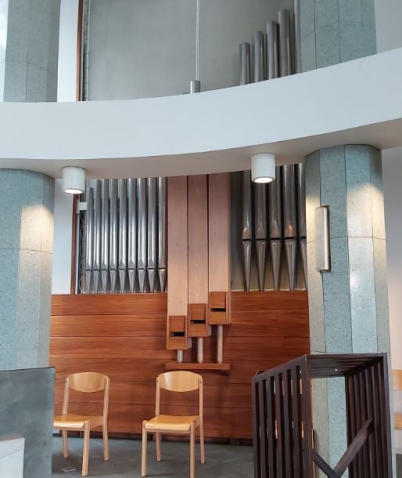
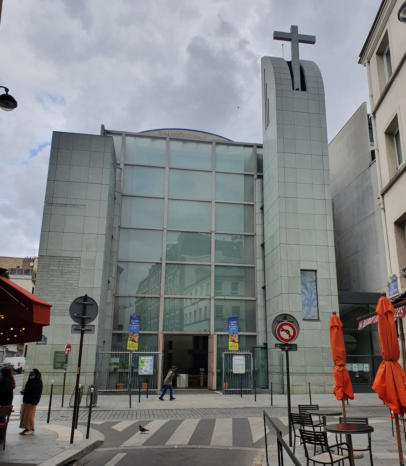
1946 - Victor Gonzalez (3)
1998 - Adrien Maciet/Marc Hédelin (3a)
2005 - Dargassies (5)
II/24 (20) -
transmissions électriques
Composition
Grand-orgue (56 notes)
Montre 8 - Bourdon 8 - Prestant 4 - Doublette 2
Plein Jeu IV - Trompette 8 - Cromorne 8
Récit expressif (56 notes)
Flûte à fuseau 8 - Salicional 8 -Voix céleste 8 -
Flûte 4 - Nasard 2 2/3 - Quarte 2 - Tierce 1 3/5 -
Cymbale III - Hautbois 8 - Trompette 8 - Clairon 4
Tremblant
Pédale (30 notes)
Soubasse 16 - Bourdon 8 - Flûte 4 (by extension)
Bombarde 16 - Trompette 8 - Clairon 4 (from GO)
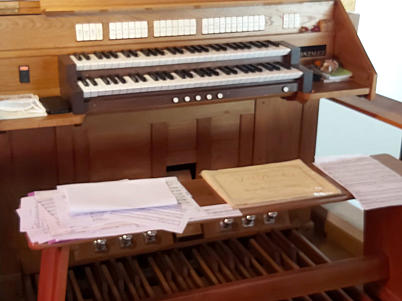
Organs of Paris
ORGANS OF PARIS © 2024 Vincent Hildebrandt ALL ORGANS
D5
According to the archives, this organ is an old cinema organ
built by John Abbey. Transformed and expanded by Victor
Gonzalez for the former little church of Our Lady of Hope in
1946, the instrument was inaugurated by André Marchal.
This organ is composed of about twenty real stops, spread
over 2 keyboards and pedals with electric traction mounted
on a separate console. There is no case and its façade is
composed of 15 tin pipes arranged in mitre and framed by 2
groups of 3 wooden pipes. The base is plywood.
Before the destruction of the old church, the organ was
dismantled and in 1998 reassembled by Marc Hédelin in the
choir of the new church. He made several important
modifications while respecting the initial stoplist of the
instrument and he rebuilt the console.
Later, the instrument was fully restored by Bernard
Dargassies.
Its piping is embedded in an alcove of the choir, masked by
stretched canvases of the same tone as the walls. Only 2
platforms of tin pipes that make up the bass of the Montre
and frame 3 wooden pipes are the visible part of the
instrument.
The console is deported to a side stand along the nave
allowing, from the keyboards, a plunging view of the choir.
With its duplication and extensions, notably on the pedal
(funds 16', 8' and 4', reeds 16', 8' and 4'), this organ of 24
stops on the console represents a fine example of the neo-
classical organ.
Text and photos: Thierry Correard.
Organiste titulaire
Vincent Guyot
Concerts
-
Masses with organ
Saturday at 6:30 p.m., Sunday 10:30 a.m.
Video
-
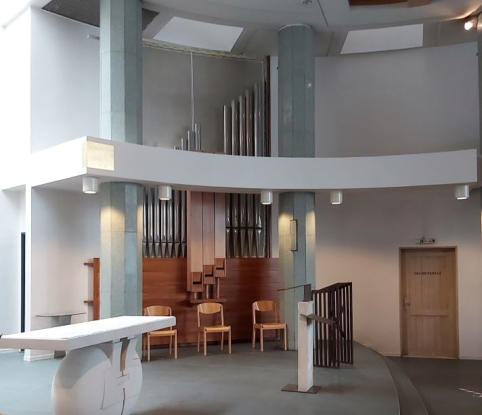
1946 - Victor Gonzalez (3)
1998 - Adrien Maciet/Marc Hédelin (3a)
2005 - Dargassies (5)
II/24 (20) -
transmissions électriques
Composition
Grand-orgue (56 notes)
Montre 8 - Bourdon 8 - Prestant 4 - Doublette 2
Plein Jeu IV - Trompette 8 - Cromorne 8
Récit expressif (56 notes)
Flûte à fuseau 8 - Salicional 8 -Voix céleste 8 -
Flûte 4 - Nasard 2 2/3 - Quarte 2 - Tierce 1 3/5 -
Cymbale III - Hautbois 8 - Trompette 8 - Clairon 4
Tremblant
Pédale (30 notes)
Soubasse 16 - Bourdon 8 - Flûte 4 (by extension)
Bombarde 16 - Trompette 8 - Clairon 4 (from GO)
